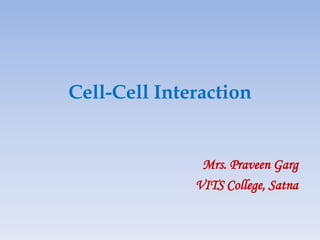
Cell cell interaction
- 1. Cell-Cell Interaction Mrs. Praveen Garg VITS College, Satna
- 2. Introduction • Cell–cell interaction refers to the direct interactions between cell surfaces that play a role in the development and function of multicellular organisms. • These interactions allow cells to communicate with each other in response to changes in their microenvironment. • This ability to send and receive signals is essential for the survival of the cell. • Interactions between cells can be stable such as those made through cell junctions. • These junctions are involved in the communication and organization of cells within a particular tissue. • The loss of communication between cells can result in uncontrollable cell growth and cancer.
- 3. Stable Interactions • Stable cell-cell interactions are required for cell adhesion within a tissue and controlling the shape and function of cells. • These stable interactions involve cell junctions which are multiprotein complexes that provide contact between neighboring cells. • Cell junctions allow the proper functioning of epithelial cell sheets. • These junctions are also important in the organization of tissues where cells of one type can only adhere to cells of the same tissue rather than to a different tissue.
- 5. Tight junctions • Tight junctions are multi-protein complexes that hold cells of a same tissue together. • It prevent movement of water and water-soluble molecules between cells. • In epithelial cells, they function also to separate the extracellular fluid surrounding their apical and basolateral membranes. • The tight junctions on adjacent cells line up so as to produce a seal between different tissues and body cavities. • For example, the apical surface of gastrointestinal epithelial cells serve as a selective permeable barrier that separates the external environment from the body.
- 7. • The permeability of these junctions is dependent on a variety of factors including protein of the junction, tissue type and signaling from the cells. • Tight junctions are made up of many different proteins. The four main transmembrane proteins are occludin, claudin, junctional adhesion molecules (JAMs) and tricellulins. • The extracellular domains of these proteins form the tight junction barrier by making homophilic (between proteins of the same kind) and heterophilic interactions (between different types of proteins) with the protein domains on adjacent cells.
- 8. Anchoring junctions • Only two junctions are involved in cell-cell interactions: adherens junctions and desmosomes. • Adjacent epithelial cells are connected by adherens junctions on their lateral membranes. • They are located just below tight junctions. Their function is to give shape and tension to cells and tissues and they are the site of cell-cell signaling. • Adherens junctions are made of cell adhesion molecules from the cadherin family. • There are over 100 types of cadherins. The most common are E-, N- and P- cadherins. • In the adherens junctions of epithelial cells, E-cadherin is the most abundant. • Desmosomes also provide strength and durability to cells and tissues and are located just below adherens junctions. • They are sites of adhesion, They are made of two specialized cadherins, desmoglein and desmocollin. These proteins have extracellular domains that interact with each other on adjacent cells. • Desmosomes also play a role in cell-cell signaling.
- 11. Gap junctions • Gap junctions are the main site of cell-cell signaling or communication that allow small molecules to diffuse between adjacent cells. • In vertebrates, gap junctions are composed of transmembrane proteins called connexins. • They form hexagonal pores or channels through which ions, sugars, and other small molecules can pass. • Each pore is made of 12 connexin molecules; 6 form a hemichannel on one cell membrane and interact with a hemichannel on an adjacent cell membrane. • The permeability of these junctions is regulated by many factors including pH and Ca2+ concentration
- 13. Receptor proteins in direct-contact signaling • Receptor proteins on the cell surface have the ability to bind specific signaling molecules secreted by other cells. • Cell signaling allows cells to communicate with adjacent cells, nearby cells (paracrine) and even distant cells (endocrine). • This binding induces a conformational change in the receptor which, in turn, elicits a response in the corresponding cell. • These responses include changes in gene expression and alterations in cytoskeleton structure. • The extracellular face of the plasma membrane has a variety of proteins, carbohydrates, and lipids which project outward and act as signals. • Direct contact between cells allows the receptors on one cell to bind the small molecules attached to the plasma membrane of different cell.
- 14. Thank You